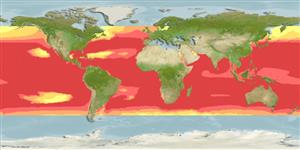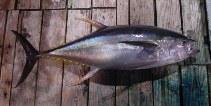把你的觀察加入 Fish Watcher
| Native range | All suitable habitat | Point map | Year 2050 |

|
| This map was computer-generated and has not yet been reviewed. |
| Thunnus albacares AquaMaps Data sources: GBIF OBIS |
上傳你的 相片 和 影像
Pictures | Videos | Stamps, coins, misc. | Google 影像Thunnus albacares
Picture by Archambault, C.
Pictures | Videos | Stamps, coins, misc. | Google 影像Thunnus albacares
Picture by Archambault, C.
Chinese Taipei (Taiwan) country information
Common names:
[No common name]
Occurrence: native
Salinity: marine
Abundance: | Ref:
Importance: commercial | Ref: FAO, 2000
Aquaculture: | Ref:
Regulations: | Ref:
Uses: no uses
Comments: Known from northern, southern, and western Taiwan (including Tai-chung (Ref. 43515) and Hsiao-liu-chiu) and from the Penghu (Ref. 55073 and Green islands (Ref. 48445). Also Ref. 9987, 43515.
National Checklist:
Country Information: https://www.cia.gov/library/publications/resources/the-world-factbook/geos/tw.html
National Fisheries Authority:
Occurrences: Occurrences Point map
Main Ref: Collette, B.B. and C.E. Nauen, 1983
National Database: The Fish Database of Taiwan
Occurrence: native
Salinity: marine
Abundance: | Ref:
Importance: commercial | Ref: FAO, 2000
Aquaculture: | Ref:
Regulations: | Ref:
Uses: no uses
Comments: Known from northern, southern, and western Taiwan (including Tai-chung (Ref. 43515) and Hsiao-liu-chiu) and from the Penghu (Ref. 55073 and Green islands (Ref. 48445). Also Ref. 9987, 43515.
National Checklist:
Country Information: https://www.cia.gov/library/publications/resources/the-world-factbook/geos/tw.html
National Fisheries Authority:
Occurrences: Occurrences Point map
Main Ref: Collette, B.B. and C.E. Nauen, 1983
National Database: The Fish Database of Taiwan
Common names from other countries
分類 / Names 俗名 | 同種異名 | Catalog of Fishes(屬, 種) | ITIS | CoL | WoRMS | Cloffa
Teleostei > Scombriformes (Mackerels) 鱸形目 (Mackerels) > Scombridae (Mackerels, tunas, bonitos) 鯖科 (Mackerels, tunas, bonitos) > Scombrinae
Etymology: Thunnus: Greek, thynnos = tunna (Ref. 45335).
More on author: Bonnaterre.
Etymology: Thunnus: Greek, thynnos = tunna (Ref. 45335).
More on author: Bonnaterre.
Environment: milieu / climate zone / depth range / distribution range 生態學
海洋; 半鹹淡水; 海洋洄游的 (Ref. 51243); 深度上下限 1 - 1602 m, usually 1 - 250 m (Ref. 6390). 熱帶; 15°C - 31°C (Ref. 168); 50°N - 50°S, 180°W - 180°E
分布 國家 | FAO區域 | 生態系 | 發現紀錄 | Point map | 簡介 | Faunafri
Worldwide in tropical and subtropical seas, but absent from the Mediterranean Sea. Highly migratory species.
遍及全球的熱帶與亞熱帶的海洋, 但是地中海沒有出現。 高度遷移的種,1982年海事法會議的附件一.(參考文獻 26139)
遍及全球的熱帶與亞熱帶的海洋, 但是地中海沒有出現。 高度遷移的種,1982年海事法會議的附件一.(參考文獻 26139)
Length at first maturity / 大小 / 重量 / 年齡
Maturity: Lm 103.3, range 78 - 158 cm
Max length : 239 cm FL 雄魚/尚未辨別雌雄; (Ref. 40637); common length : 150 cm FL 雄魚/尚未辨別雌雄; (Ref. 168); 最大體重: 200.0 kg (Ref. 26550); 最大年齡: 9 年 (Ref. 72462)
Max length : 239 cm FL 雄魚/尚未辨別雌雄; (Ref. 40637); common length : 150 cm FL 雄魚/尚未辨別雌雄; (Ref. 168); 最大體重: 200.0 kg (Ref. 26550); 最大年齡: 9 年 (Ref. 72462)
簡短描述 檢索表 | 型態特徵 | 形態測量圖
背棘 (總數) : 11 - 14; 背的軟條 (總數) : 12 - 16; 臀棘: 0; 臀鰭軟條: 11 - 16; 脊椎骨: 39. This large species is distinguished by the following characters: elongate, fusiform body, slightly compressed laterally; total gill rakers on first gill arch 26-34; dorsal fins 2 and separated only by a narrow interspace, the second followed by 8-10 finlets; anal fin followed by 7 to 10 finlets; large specimens may have very long second dorsal and anal fins, becoming well over 20% of fork length; pectoral fins moderately long, usually reaching beyond second dorsal-fin origin but not beyond end of its base, usually 22-31% of FL; 2 flaps (interpelvic process) between pelvic fins; body with very small scales; corselet of larger scales developed but not very distinct; caudal peduncle very slender, bearing on each side a strong lateral keel between 2 smaller keels; no striations on ventral surface of liver; swimbladder present. Colour of back metallic dark blue changing through yellow to silver on belly; belly frequently crossed by about 20 broken, nearly vertical lines; dorsal and anal fins, and dorsal and anal finlets bright yellow, the finlets with a narrow black border (Ref. 9684).
魚具有非常長的第二背鰭鰭與臀鰭, 在一些裡面可能達到遠超過 20% 的 FL。 胸鰭是中等長度的, 通常超過第二個背鰭起點但是不超過它的基底的末端。 色彩是黑色的金屬深藍色改變過黃色到銀色的在腹面上。 腹面時常有大約 20條斷掉的, 幾乎垂直的線。 背鰭與臀鰭與離鰭是鮮黃色的。
魚具有非常長的第二背鰭鰭與臀鰭, 在一些裡面可能達到遠超過 20% 的 FL。 胸鰭是中等長度的, 通常超過第二個背鰭起點但是不超過它的基底的末端。 色彩是黑色的金屬深藍色改變過黃色到銀色的在腹面上。 腹面時常有大約 20條斷掉的, 幾乎垂直的線。 背鰭與臀鰭與離鰭是鮮黃色的。
An oceanic species occurring above and below the thermoclines. Pelagic in open water , but rarely seen near reefs (Ref. 48637). They school primarily by size, either in monospecific or multi-species groups. Larger fish frequently school with porpoises, also associated with floating debris and other objects. Feed on fishes, crustaceans and squids. It is sensitive to low concentrations of oxygen and therefore is not usually caught below 250 m in the tropics (Ref. 28952, 30329). Peak spawning occurs during the summer, in batches (Ref. 9684, 51846). Eggs and larvae are pelagic (Ref. 6769). Encircling nets are employed to catch schools near the surface (Ref. 9340). Caught mainly with longlines and purse seines. Marketed mainly fresh, frozen, canned (Ref. 9684), but also smoked (Ref. 9987). Highly valued for sashimi (Ref. 26938).
出現在溫水層上下的一個大洋性的種。 大洋性的,在開放水域中 , 但是很少見到在礁的附近.(參考文獻 48637) 他們主要依照大小群集, 形成單一魚種或多種群。 較大的魚時常與鼠海豚一起群游, 也伴隨著漂浮的殘礫與其他的目標。 捕食魚,甲殼動物與烏賊。 分批產卵者是.(參考文獻 51846) 它是對低溶氧量敏感因此不常在熱帶中被在 250 公尺之下捕捉.(參考文獻 28952,30329) 生殖高峰發生於夏天, 成批.(參考文獻 9684) 圍網被用來捕捉魚群接近水表面。 (參考文獻 9340) 主要地在市場上銷售凍結而且裝於罐頭 (參考文獻 9684), 也生鮮地 (參考文獻 9340) 而且煙燻.(參考文獻 9987) 高度價值用作生魚片.(參考文獻 26938)
出現在溫水層上下的一個大洋性的種。 大洋性的,在開放水域中 , 但是很少見到在礁的附近.(參考文獻 48637) 他們主要依照大小群集, 形成單一魚種或多種群。 較大的魚時常與鼠海豚一起群游, 也伴隨著漂浮的殘礫與其他的目標。 捕食魚,甲殼動物與烏賊。 分批產卵者是.(參考文獻 51846) 它是對低溶氧量敏感因此不常在熱帶中被在 250 公尺之下捕捉.(參考文獻 28952,30329) 生殖高峰發生於夏天, 成批.(參考文獻 9684) 圍網被用來捕捉魚群接近水表面。 (參考文獻 9340) 主要地在市場上銷售凍結而且裝於罐頭 (參考文獻 9684), 也生鮮地 (參考文獻 9340) 而且煙燻.(參考文獻 9987) 高度價值用作生魚片.(參考文獻 26938)
Life cycle and mating behavior 成熟度 | 繁殖 | 產卵場 | 卵 | 孕卵數 | 仔魚
Spawn throughout the tropical and equatorial waters of the major oceans (Ref. 6390). At higher latitudes, spawning is seasonal, with peaks in summer; may continue throughout the year at lower latitudes (Ref. 6390).
Yellowfin tuna are multiple spawners, ie they spawn every few days over the spawning period (Ref. 6390). Eggs and sperm are released into the water for fertilisation (Ref. 6390).遍及全球的熱帶與亞熱帶的海洋, 但是地中海沒有出現。 高度遷移的種,1982年海事法會議的附件一.(參考文獻 26139)
主要參考資料
Upload your references | 參考文獻 | 合作者 : Collette, Bruce B. | 合作者
Collette, B.B. and C.E. Nauen, 1983. FAO Species Catalogue. Vol. 2. Scombrids of the world. An annotated and illustrated catalogue of tunas, mackerels, bonitos and related species known to date. Rome: FAO. FAO Fish. Synop. 125(2):137 p. (Ref. 168)
對人類具威脅
無害處的
人類使用
漁業: 高經濟性; 養殖: 實驗的; 游釣魚種: 是的
FAO(Aquaculture systems: 產生; 漁業: 產生, 魚種描繪; publication : search) | FIRMS (Stock assessments) | FishSource | 周邊海洋
更多資訊
Population dynamics
成長參數
Max. ages / sizes
Length-weight rel.
Length-length rel.
長度-頻率
Mass conversion
入添量
豐度
成長參數
Max. ages / sizes
Length-weight rel.
Length-length rel.
長度-頻率
Mass conversion
入添量
豐度
Physiology
Body composition
Nutrients
耗氧量
游泳類型
游泳速度
Visual pigments
Fish sound
Diseases & Parasites
Toxicity (LC50s)
Body composition
Nutrients
耗氧量
游泳類型
游泳速度
Visual pigments
Fish sound
Diseases & Parasites
Toxicity (LC50s)
工具
E-book | 野外調查 | 檢索表 | 長度- 頻率 Wizard | 生活- 歷史的工具 | 分布圖 | Classification Tree
| Catch-MSY |
特別的報告
下載 XML
網路資源
Aquatic Commons | BHL | Cloffa | BOLDSystems | Websites from users | 檢查 FishWatcher | CISTI | Catalog of Fishes(屬, 種) | DiscoverLife | ECOTOX | Faunafri | Fishtrace | GenBank(基因組, 核甘) | GloBI | GOBASE | GoMexSI (interaction data) | | Google Books | Google Scholar | Google | IGFA World Record | MitoFish | 國家資料庫 | OsteoBase(skull, spine) | Otolith Atlas of Taiwan Fishes | 公眾的水族館 | PubMed | Reef Life Survey | 魚類百科全書 | Scirus | SeaLifeBase | 樹狀分類階層 | Wikipedia(去, 搜尋) | World Records Freshwater Fishing | 動物學的記錄
Estimates based on models
Preferred temperature (Ref. 115969): 16.5 - 28.9, mean 26.7 (based on 6382 cells).
Phylogenetic diversity index (Ref. 82804): PD50 = 0.5039 [Uniqueness, from 0.5 = low to 2.0 = high].
Bayesian length-weight: a=0.01445 (0.01183 - 0.01766), b=3.03 (2.99 - 3.07), in cm Total Length, based on LWR estimates for this species (Ref. 93245).
營養階層 (Ref. 69278): 4.4 ±0.4 se; based on diet studies.
回復力 (Ref. 120179): 中等的, 族群倍增時間最少 1.4 - 4.4年 (K=0.13-0.42; tm=2-5; tmax=8; Fec=200,000).
Prior r = 0.36, 95% CL = 0.24 - 0.54, Based on 9 full stock assessments.
Fishing Vulnerability (Ref. 59153): Moderate to high vulnerability (46 of 100).
Climate Vulnerability (Ref. 125649): Moderate vulnerability (42 of 100).




